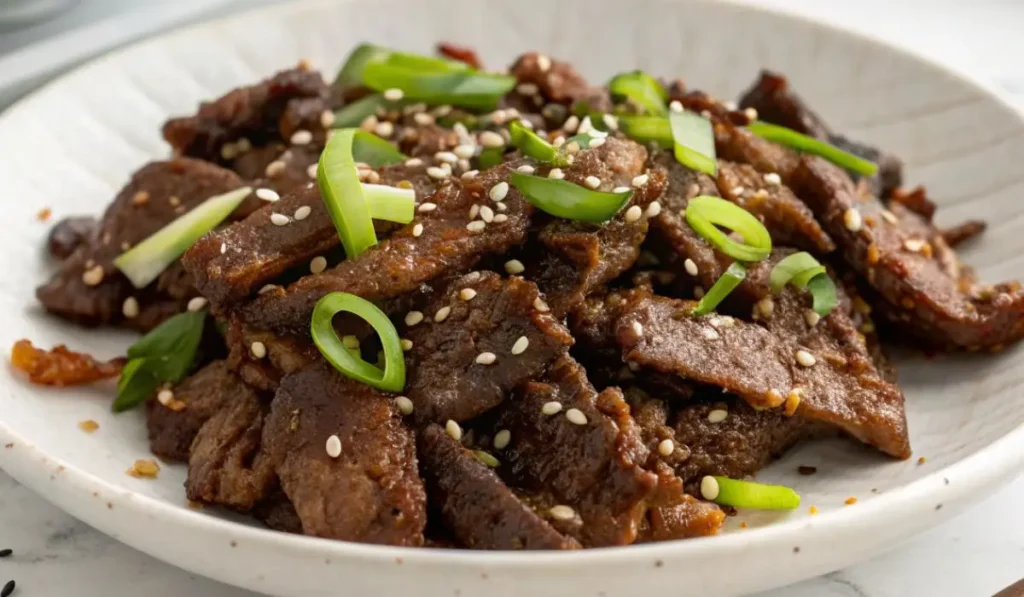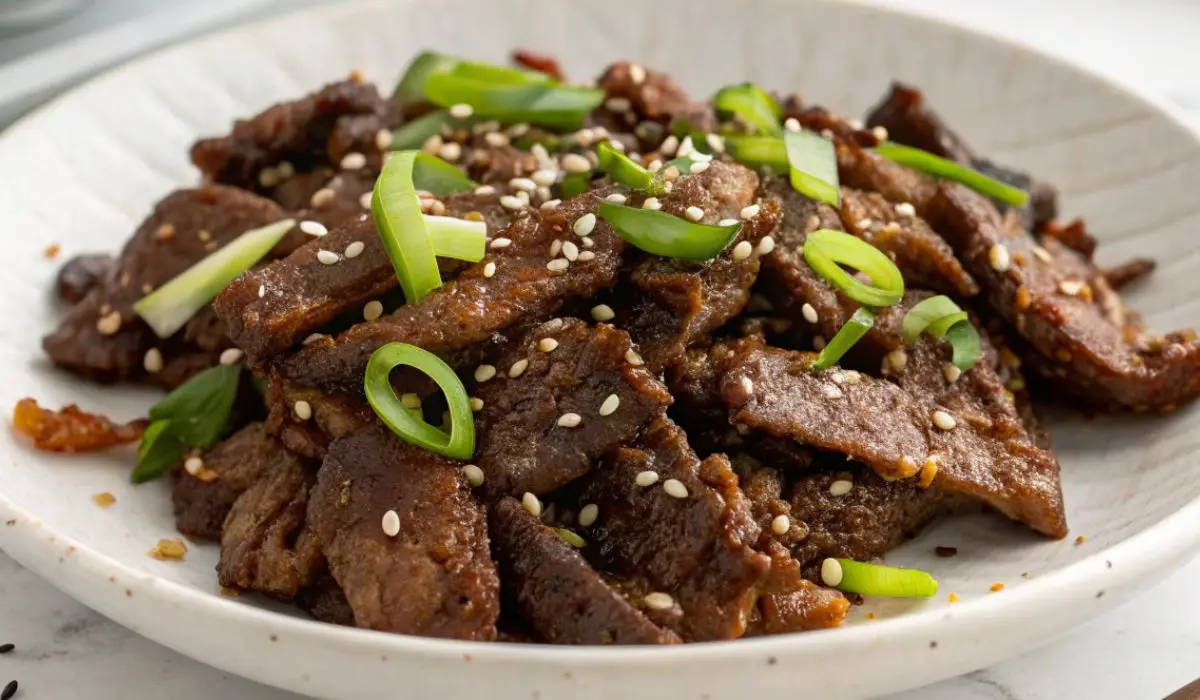This bulgogi recipe brings the authentic taste of Korean BBQ straight to your kitchen with tender, marinated beef that cooks in minutes.
After making this dish countless times for my family and friends, I can confidently say it delivers restaurant-quality flavors using simple ingredients you can find at any grocery store.
The secret lies in the perfect balance of sweet and savory marinade that tenderizes the meat while infusing it with incredible depth of flavor.

Essential Ingredients for Korean Bulgogi
Creating the perfect Korean beef bulgogi starts with selecting the right ingredients. Here’s what you’ll need for this traditional recipe:
- 1½ pounds boneless ribeye steak – The marbled fat creates tender, flavorful results
- ½ small Korean pear, grated – Acts as a natural meat tenderizer and adds subtle sweetness
- ¼ cup reduced sodium soy sauce – Provides the signature umami base
- 2 tablespoons brown sugar – Balances the saltiness and helps with caramelization
- 2 tablespoons toasted sesame oil – Adds nutty, aromatic depth
- 3 cloves garlic, minced – Essential for authentic Korean flavor
- 1 tablespoon fresh ginger, grated – Brings warmth and complexity
- 1 tablespoon gochujang – Korean red pepper paste for mild heat and color
- 2 tablespoons vegetable oil – For cooking the marinated beef
- 2 green onions, sliced – Fresh garnish that adds color and mild onion flavor
- 1 teaspoon toasted sesame seeds – Traditional finishing touch
Step-by-Step Instructions
Follow these detailed steps to create perfectly cooked bulgogi every time:
- Prepare the meat: Wrap ribeye steak in plastic wrap and freeze for 30 minutes. This makes slicing much easier and ensures paper-thin cuts.
- Slice against the grain: Remove from freezer and cut into ¼-inch thick slices across the grain for maximum tenderness.
- Make the marinade: Combine grated pear, soy sauce, brown sugar, sesame oil, minced garlic, grated ginger, and gochujang in a medium bowl.
- Marinate the beef: Place sliced steak and marinade in a gallon-sized zip-lock bag. Marinate for at least 2 hours or overnight, turning occasionally.
- Heat your pan: Use a cast iron grill pan over medium-high heat with 1 tablespoon vegetable oil.
- Cook in batches: Add marinated beef in a single layer, avoiding overcrowding. Cook 2-3 minutes per side until charred.
- Repeat the process: Use remaining oil and cook the rest of the beef in batches.
- Garnish and serve: Top with sliced green onions and toasted sesame seeds.
Pro Tips for Restaurant-Quality Korean Bulgogi
These expert techniques will elevate your homemade bulgogi to professional levels:
- Freeze before slicing: This technique ensures uniform, thin cuts that cook evenly and absorb marinade better.
- Don’t skip the pear: Korean pear or Bosc pear contains enzymes that naturally tenderize meat while adding sweetness.
- Use cast iron cookware: Heavy-bottom pans retain heat better, creating the perfect sear and smoky flavors.
- Avoid overcrowding: Cook in small batches to prevent steaming and ensure proper caramelization.
- Let it rest: Allow marinated meat to come to room temperature before cooking for even results.
Storage and Meal Prep Solutions
Korean bulgogi is incredibly freezer-friendly, making it perfect for busy weeknight dinners:
- Fresh storage: Keep leftovers in the refrigerator for 2-3 days in an airtight container.
- Freezing raw marinated meat: Store in freezer bags for up to 2 months before cooking.
- Freezing cooked bulgogi: Cool completely, then freeze in portions for up to 2 months.
- Reheating instructions: Thaw overnight in the refrigerator, then reheat over medium-high heat while stirring frequently.
Traditional Korean BBQ Serving Suggestions
Bulgogi tastes best when served the traditional Korean way with complementary sides:
- Steamed white rice: The classic base that soaks up the flavorful bulgogi juices
- Fresh lettuce wraps: Use butter lettuce or romaine for a low-carb option
- Kimchi: Fermented vegetables that cut through the rich, savory meat
- Ssamjang: Korean BBQ dipping sauce that adds extra depth
- Pickled vegetables: Cucumber or radish pickles provide refreshing contrast
- Perilla leaves: Traditional Korean herb that pairs beautifully with grilled meat
Alternative Cuts and Budget-Friendly Options
While ribeye produces the most tender results, these alternatives work well for budget-conscious cooks:
- Top sirloin: Slightly leaner but still tender when sliced thin
- Flank steak: More affordable option that becomes tender through proper marinating
- Skirt steak: Quick-cooking cut that works well with the traditional marinade
- Pre-sliced bulgogi beef: Available at Korean grocery stores for convenience
This authentic bulgogi recipe has become a weekly staple in my household because it delivers incredible flavor with minimal effort.
The combination of sweet, savory, and slightly spicy flavors creates an addictive taste that keeps everyone coming back for more.
Whether you’re hosting a Korean BBQ night or just want a quick weeknight dinner, this bulgogi recipe never fails to impress.

Korean Beef Bulgogi
Ingredients
Equipment
Method
- Wrap the ribeye steak in plastic wrap and place in the freezer for 30 minutes. This will make it easier to slice thinly.
- Remove the steak from freezer and unwrap. Using a sharp knife, slice the steak across the grain into ¼-inch thick slices.
- In a medium bowl, combine the grated pear, soy sauce, brown sugar, sesame oil, minced garlic, grated ginger, and gochujang. Mix well to create the marinade.
- Place the sliced steak and marinade in a gallon-size zip-lock bag. Seal and massage gently to coat all pieces. Marinate for at least 2 hours or overnight in the refrigerator, turning the bag occasionally.
- Heat 1 tablespoon of vegetable oil in a cast iron grill pan over medium-high heat until hot and shimmering.
- Working in batches to avoid overcrowding, add the marinated steak to the pan in a single layer. Cook for 2-3 minutes per side until charred and cooked through.
- Remove the first batch and repeat with the remaining tablespoon of oil and remaining steak pieces.
- Serve immediately, garnished with sliced green onions and toasted sesame seeds. Enjoy with steamed rice and Korean side dishes.
